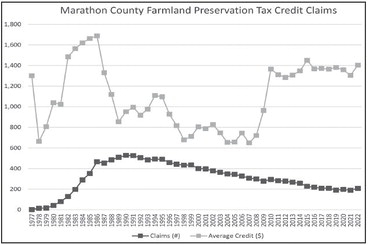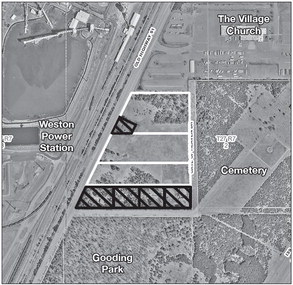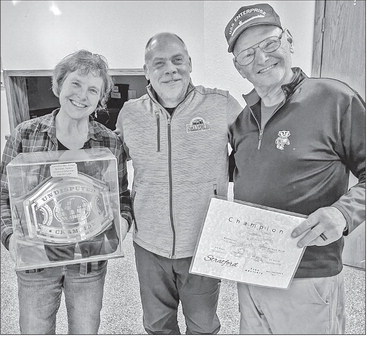Farmland Preservation update ready for OK


By Kevin O’Brien
A newly updated Farmland Preservation Plan, which is largely the same as the current plan adopted in 2013, is ready for approval by the Marathon County Board of Supervisors at its next business meeting on June 18.
Following a brief overview by county conservationist Kirstie Heidenreich at its June 4 meeting, the Environmental Resources Committee voted unanimously to recommend approval of the 66-page document to the full county board.
Heidenreich said Conservation, Planning and Zoning (CPZ) has been working on updating the plan for months based on input from town officials. CPZ staff have also made further changes after an initial review by the Department of Agriculture, Trade and Consumer Protection (DATCP), which must certify the plan before it goes into effect.
As opposed to the 2013 update, which required a complete rewrite of a plan from 1982, this latest revision is more minor.
“Many of the foundational aspects of the 2013 plan remain substantially unchanged and relevant in 2024, as there has not been widespread changes in demographics, land use, and the agricultural industry in the past 11 years in Marathon County,” the plan states.
However, the plan does call attention to a number of continuing trends in the ag industry, such as a 48 percent drop in the number of farms with milk cows, from 677 in 2012 to 353 in 2022. During the same time period, the number of dairy cows increased by 2.8 percent, to 65,598 in 2022, according to the plan. A similar trend was noted with the number of beef cattle, which saw a 35 percent increase from 2012-2022, while the number of beef cattle farms rose by just under 12 percent.
Crop farming in Marathon County also continues to change, according to the plan.
“In 2022, forage land used for hay, haylage, grass silage, and greenchop was the largest crop by acreage (97,948 acres) grown in the county,” the plan states. “Corn used for grain is second at 89,973 acres, followed by soybeans at 67,481 acres. However, the acres of soybeans are increasing rapidly, with an increase of 29.2 percent from 2012-2022.”
Marathon County continues to be the top ginseng-growing county in Wisconsin, producing 90 to 95 percent of the ginseng grown in the United States, the plan states.
Chapter 6 of the plan outlines the steps that can be taken to continue preserving prime farmland within the county through various policies, ordinances and zoning. The goals and objectives include everything from providing “safe and affordable housing” to establishing “a revolving loan fund to assist new farmers in entering the industry.”
The plan details how the county identifies Farmland Preservation areas within its rural communities and how the preservation plan will be implemented over the next 10 years. One of the main tools for preserving farmland is the county’s zoning code, which requires lots with a minimum of 35 acres to qualify for Farmland Preservation zoning.
The county, in conjunction with the state, also incentivizes farmland preservation through annual income tax credits, which are $10 per ace for any qualifying land in a Farmland Preservation zoning district, $10 per acre for landowners with a 10-year Farmland Preservation Agreement, or $12.50 per acre for those who meet both criteria.
In addition to adopting a new Farmland Preservation Plan, the county also needs to update a portion of its comprehensive plan by the end of the year in order to maintain the tax credits through DATCP.
“I don’t know how much money comes into Marathon County every year from those tax credits, but I’m sure it’s probably in the millions,” Heidenreich said. “It’s a lot of money.”
n The committee voted 5-4 to reject a petition by Tyler Seehafer, a farmer in the town of Marathon, to amend the county’s zoning code regarding farm consolidations. The proposed amendment would have allowed an older farm residence to be relocated within the parcel it is located and remain eligible for farmland consolidation, which removes the need for rezoning.
“This text amendment would allow for the consolidation of a farmstead in Farmland Preservation Zoning to occur if the farm residence, constructed before January 1, 2014, to proceed if the farm residence has been moved to a new location on the existing parcel that would be in alignment with the purpose of the Farmland Preservation purpose statement,” Seehafer wrote.
Seehafer said he came up with the proposal after purchasing a parcel with an old house on it, which he moved in order to free up more farmland.
Paul Daigle, former CPZ director, spoke in favor of Seehafer’s amendment, noting that moving the old house on Seehafer’s property increased the amount of available farmland and reduced potential conflicts between farming and any potential occupant of the house.
The town of Marathon’s planning commission came out against the amendment, saying it unnecessarily complicates the rezoning process. ERC chair Jacob Langenhahn, who represents the town of Marathon, made a motion to deny the petition, and it passed by a one-vote margin.
n The committee voted 6-3 to advance a petition from the town of Plover to allow shipping containers to be used as permanent storage structures within residential zones of county-zoned towns. The proposal had been discussed several times previously and was modified based on comments from town officials. If adopted by the full board, landowners in county-zoned towns could get a conditional- use permit from the board of adjustment to place a shipping container on their property.
TAX CREDITS- This graph in Marathon County’s 2024 Farmland Preservation Plan shows the number and value of tax credits claimed by landowners in the county who abide by farmland preservation rules.
SUBMITTED PHOTO
Other business



